第4课:科技英语词汇特点与翻译
- 格式:ppt
- 大小:718.50 KB
- 文档页数:53
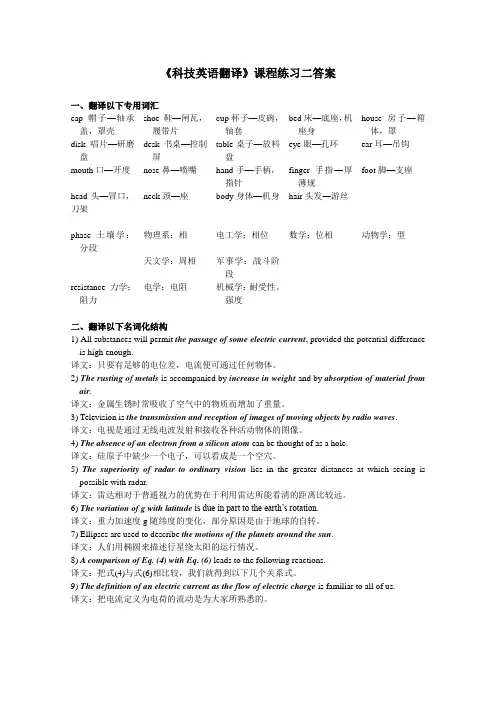
《科技英语翻译》课程练习二答案一、翻译以下专用词汇cap帽子—轴承盖,罩壳shoe鞋—闸瓦,履带片cup杯子—皮碗,轴套bed床—底座,机座身house房子—箱体,罩disk唱片—研磨盘desk书桌—控制屏table桌子—放料盘eye眼—孔环ear耳—吊钩mouth口—开度nose鼻—喷嘴hand手—手柄,指针finger手指—厚薄规foot脚—支座head头—冒口,刀架neck颈—座body身体—机身hair头发―游丝phase 土壤学:分段物理系:相电工学:相位数学:位相动物学:型天文学:周相军事学:战斗阶段resistance 力学:阻力电学:电阻机械学:耐受性、强度二、翻译以下名词化结构1) All substances will permit the passage of some electric current, provided the potential difference is high enough.译文:只要有足够的电位差,电流便可通过任何物体。
2) The rusting of metals is accompanied by increase in weight and by absorption of material from air.译文:金属生锈时常吸收了空气中的物质而增加了重量。
3) Television is the transmission and reception of images of moving objects by radio waves.译文:电视是通过无线电波发射和接收各种活动物体的图像。
4) The absence of an electron from a silicon atom can be thought of as a hole.译文:硅原子中缺少一个电子,可以看成是一个空穴。
5) The superiority of radar to ordinary vision lies in the greater distances at which seeing is possible with radar.译文:雷达相对于普通视力的优势在于利用雷达所能看清的距离比较远。
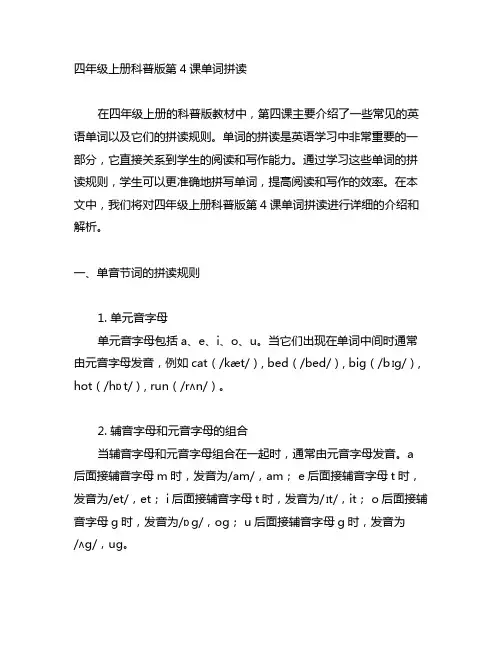
四年级上册科普版第4课单词拼读在四年级上册的科普版教材中,第四课主要介绍了一些常见的英语单词以及它们的拼读规则。
单词的拼读是英语学习中非常重要的一部分,它直接关系到学生的阅读和写作能力。
通过学习这些单词的拼读规则,学生可以更准确地拼写单词,提高阅读和写作的效率。
在本文中,我们将对四年级上册科普版第4课单词拼读进行详细的介绍和解析。
一、单音节词的拼读规则1. 单元音字母单元音字母包括a、e、i、o、u。
当它们出现在单词中间时通常由元音字母发音,例如cat(/kæt/), bed(/bed/), big(/bɪg/), hot(/hɒt/), run(/rʌn/)。
2. 辅音字母和元音字母的组合当辅音字母和元音字母组合在一起时,通常由元音字母发音。
a 后面接辅音字母m时,发音为/am/,am; e后面接辅音字母t时,发音为/et/,et; i后面接辅音字母t时,发音为/ɪt/,it; o后面接辅音字母g时,发音为/ɒg/,og; u后面接辅音字母g时,发音为/ʌg/,ug。
二、多音节词的拼读规则1. 长元音和短元音长元音和短元音在多音节词的拼读中非常重要。
长元音通常由两个字母表示,而短元音通常只由一个字母表示。
cake中的a为长元音,发音为/keɪk/; cat中的a为短元音,发音为/kæt/。
2. 辅音字母和元音字母的组合在多音节词中,辅音字母和元音字母的组合不仅要注意元音字母的发音,还要注意辅音字母的发音。
ea组合在一起的时候可以发音为/ɪə/,/eə/,/eɪ/,/æ/,具体的发音还要根据具体情况而定。
三、单词拼读的练习方法1. 阅读练习通过大量的阅读练习,学生可以熟悉单词的拼读规则,培养自己的阅读能力。
2. 拼写练习学生可以通过听音填空、单词拼写等练习来巩固单词的拼读规则,提高自己的拼写能力。
3. 语音练习学生可以通过模仿老师的发音或者录音对比的方式来训练自己的语音,提高自己的发音准确性。
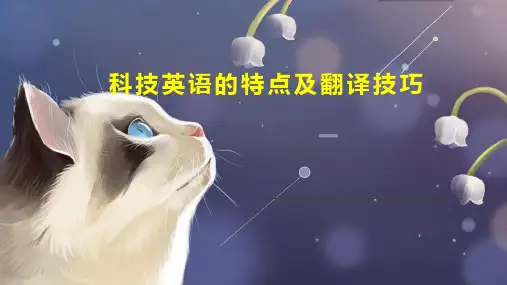


六年级下册英语第四课单词科普版全文共3篇示例,供读者参考篇1Unit 4 Vocabulary ExplorationWhat's up, fellow students? It's your friendly neighborhood word nerd here to take you on an epic journey through the amazing vocabulary from Unit 4 of our English textbook. Get ready to expand your mind and impress your friends with your newfound lexical prowess!Let's kick things off with the word "summit." Now, you might be thinking, "Summit? Isn't that just a fancy word for the top of a mountain?" Well, you're not wrong, but there's more to it than that. A summit can also refer to an important meeting or conference, usually involving world leaders or super important people. Imagine the President of the United States and the Prime Minister of Canada having a "summit" to discuss things like trade agreements or global warming. Pretty cool, right?Next up, we've got "mechanism." This word might sound a bit robotic, but it's actually super useful. A mechanism is basically a fancy way of saying "a process or system that does something."For example, your body has all sorts of mechanisms that keep you alive, like your digestive mechanism that breaks down the food you eat. Or, you could talk about the mechanisms of a clock that make the hands move. Mechanisms are everywhere, keeping the world running smoothly.Now, let's dive into "prosperous." This word is all about success and wealth. If someone or something is prosperous, it means they're doing really well financially. You could say that a prosperous business is making a lot of money and doing great. Or, you could describe a prosperous country as one with a strong economy and plenty of resources. Basically, if something is prosperous, it's living the good life.Moving on, we've got "incessant." This word might look a bit intimidating, but it's actually pretty easy to understand. Incessant means "never-ending" or "continuous." For example, you could describe the incessant rain during a thunderstorm, or the incessant chatter of your little sibling who just won't stop talking. Incessant is one of those words that really drives home the idea of something happening over and over again, without stopping.Next, we've got "excerpt." An excerpt is like a little snippet or piece taken from a larger work. For instance, if you read a short passage from a novel in your English class, that would beconsidered an excerpt from the book. Or, if you watch a clip from a movie or TV show, that's an excerpt from the full production. Excerpts are great for giving you a taste of something without having to experience the whole thing.Now, let's talk about "immerse." To immerse yourself in something means to fully engage with it or become completely involved in it. For example, you might immerse yourself in a good book, getting so caught up in the story that you lose track of time. Or, you could immerse yourself in a new hobby like painting or playing an instrument, dedicating a lot of time and effort to mastering it.Moving right along, we've got "adapt." Adapt is all about making changes or adjustments to fit new circumstances or situations. For instance, animals have to adapt to changes in their environment, like finding new sources of food or shelter. Or, you might have to adapt to a new school by making new friends and adjusting to different rules and routines. Adapting is all about being flexible and rolling with the punches.Next up, we've got "scarce." Something that's scarce is in short supply or hard to find. For example, water can be scarce in certain parts of the world that experience droughts or lack access to clean water sources. Or, you could say that good grades arescarce in your class because everyone finds the material really challenging. Basically, if something is scarce, it's rare and hard to come by.Now, let's explore "consent." Consent is all about giving permission or agreement for something to happen. For instance, if you want to borrow your friend's pen, you need to get their consent first. Or, if you're going to share someone's personal information, you should have their consent to do so. Consent is super important because it shows respect for other people's choices and boundaries.Finally, we've got "violate." To violate something means to break a rule, law, or agreement. For example, if you cheat on a test, you're violating the school's honor code. Or, if you trespass on someone's property without permission, you're violating their property rights. Violating rules or laws can often lead to consequences or punishments, so it's generally a good idea to avoid doing it.Phew, that was quite the vocabulary adventure, wasn't it? But don't worry, fellow word nerds – we've only just scratched the surface of the amazing world of English vocabulary. Keep exploring, keep learning, and keep expanding your mind. Whoknows, maybe one day you'll be the one writing these vocab explorations for future generations of students!篇2Unit 4 Vocabulary ExplorationHey guys! For this unit's vocab words, I thought I'd give you the inside scoop on where these words actually come from and some cool facts about them. Learning vocabulary is way more fun when you know the juicy backstories, right?Let's start with the word "adopt." This one traces back to the Latin word "adoptare" which literally means "to choose for oneself." The Romans used it in a legal context of formally taking someone as your own child. These days we use it for kids or pets, but also for things like adopting a highway to clean up!Then we have "adult." This comes from the Latin "adolescere" meaning "to grow up" or "mature." Funny enough, the Latin root is where we get the word "adolescent" too. An adult is someone who has been through that adolescent phase and (supposedly) become fully mature.What about "behave"? This one has an interesting origin from the Old English "behabban" which meant "to contain, have control over." So to behave literally means to have control orcommand over your own actions. The origins capture that sense of restraint and discipline we associate with good behavior.The word "brave" links back to the Latin "bravus" which just meant "crude, fierce, or defiant." It evolved to describe someone who confronts danger in a fierce, defiant way - our modern understanding of bravery. Funny how a word for rudeness transformed into one for courage!Sticking with cool root origins, "cellphone" traces back to the Latin "cella" meaning a "small room." So our mobile phones started out being named for their small enclosures holding the electrics and batteries. Maybe not the coolest backstory, but it beats me!Now for "checkout." This is actually a new compound word, joining "check" (from the ancient Persian "shah" meaning "king") with the straightforward "out." So checking out is the kingly process of verifying what you've got before leaving, I guess!Next up is "chore." This one comes from t he Greek "χωρα" (khora) literally meaning "this place around here." It came to describe the labor and toils associated with a place - the chores of maintaining it. Who knew our dreaded household tasks had such an unglamorous semantic journey?Then we have "entry," which traces to the French "entrer" meaning to go or come into. So an entry is the way you gain entrance or access to someplace. The noun form highlights that it's not just the act of entering, but the specific means or opening you use.How about "equal"? This one has an elegant Latin root "aequalis" which combines "aequus" (level) with a suffix implying "being in a condition of." To be equal is to be on that same balanced, level plane as someone or something else. Beautifully descriptive!Let's do a couple more... "neighborhood" ultimately comes from combining the words for "near" and "dwelling place." Makes total sense when you think about it as the dwellings situated close together.Finally, "volunteer" has a fascinating backstory. It comes from Latin "voluntarius" meaning "of one's free will." This root gave us words like "volition" and "voluntary." So a volunteer freely chooses of their own volition to offer their services. Knowing that adds character to the word.Whew, I'm all vocabulary-d out for today! See, words can be way more interesting when you peek behind the curtain at their origins and evolutions. I hope getting these kinds of fun factsmade some of these words stickier in your brain. Let me know if you'd like me to vocabulary nerd-out on the next unit too. Peace!篇3Unit 4 Vocab Explained - A Kid's GuideHey guys, it's me again, here to break down all the crazy vocab words we're supposed to memorize for Unit 4 of our English book. I tried to make it fun and use examples you can relate to. Let's get started!Appetite - This one refers to your desire to eat food. Like when you haven't eaten all day and you're starving, you have a big appetite. Or if you just finished Thanksgiving dinner, you probably have zero appetite left!Bland - Something that is bland has no flavor or is just really plain and boring. Like if your mom forgets to put seasoning on the chicken, you might say "Ugh, this chicken is so bland." Opposite of spicy or tasty.Cuisine - This is a fancy word for a style of cooking or the food from a certain culture or region. So you could talk about Mexican cuisine, Chinese cuisine, or even just home-style American cuisine.Delicacy - A delicacy is a rare or expensive food item that is considered a special treat. Like caviar (fish eggs) or truffles (underground mushrooms) would be considered delicacies that rich people eat.Famished - If you're extremely hungry, like you haven't eaten in forever, you could say you're famished. "I'm so famished, I could eat a horse!"Flavorful - The opposite of bland. When something has a really strong, tasty flavor, you could call it flavorful. Your mom's spaghetti sauce is probably flavorful if she loads it up with garlic and herbs.Gobble - To gobble is to eat really quickly without manners, kind of like how a turkey eats! You might gobble down your food if you're in a huge hurry.Munch - This is a fun way to say you're snacking on something, usually foods you can just keep putting in your mouth like chips, popcorn, crackers etc. "I was just munching on some potato chips."Nutrition - This refers to the nutrients in foods that are good for your health and help your body function properly. You learn about nutrition in health class.Palatable - When something is palatable, it means it tastes good and is pleasant to eat. The opposite would be unpalatable, which means gross or disgusting to eat.Picky - A picky eater is someone who is really fussy and only likes certain foods prepared a very specific way. Little kids are often picky eaters.Portion - A portion is how much of a certain food you get, like a portion of fries or a portion of cake. You get larger portions at buffet restaurants.Savor - To savor means to really enjoy and appreciate the flavor of your food by eating it slowly. You savor a delicious homemade meal, not gobble it down.Spicy - A food that is spicy has a hot and intense flavor from ingredients like chili peppers or curry powder. Some people love spicy foods, others can't handle it!Stale - When food has been sitting out too long and has gone dry and lost its freshness, you could say it's stale. Stale bread or chips taste pretty gross.Thirst - Thirst is the feeling of needing or wanting to drink something, usually water, when you're dehydrated. You get thirsty after running around a lot.Zest - Zest refers to how flavorful and intense something tastes. You could say "This lemonade has such a zesty flavor!" Or your food has a real zest or kick to it.Whew, that's all 18 vocab words we had to cover! Hopefully my student-friendly examples make more sense than the definitions in the textbook. Food is something we can all relate to as kids. Let me know if any words still have you starving for a better explanation!。
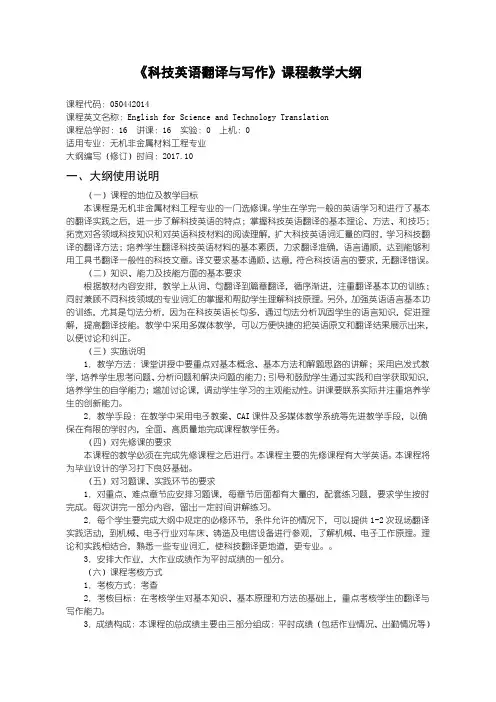
《科技英语翻译与写作》课程教学大纲课程代码:050442014课程英文名称:English for Science and Technology Translation课程总学时:16 讲课:16 实验:0 上机:0适用专业:无机非金属材料工程专业大纲编写(修订)时间:2017.10一、大纲使用说明(一)课程的地位及教学目标本课程是无机非金属材料工程专业的一门选修课。
学生在学完一般的英语学习和进行了基本的翻译实践之后,进一步了解科技英语的特点;掌握科技英语翻译的基本理论、方法、和技巧;拓宽对各领域科技知识和对英语科技材料的阅读理解,扩大科技英语词汇量的同时,学习科技翻译的翻译方法;培养学生翻译科技英语材料的基本素质,力求翻译准确,语言通顺,达到能够利用工具书翻译一般性的科技文章。
译文要求基本通顺、达意,符合科技语言的要求,无翻译错误。
(二)知识、能力及技能方面的基本要求根据教材内容安排,教学上从词、句翻译到篇章翻译,循序渐进,注重翻译基本功的训练;同时兼顾不同科技领域的专业词汇的掌握和帮助学生理解科技原理。
另外,加强英语语言基本功的训练,尤其是句法分析,因为在科技英语长句多,通过句法分析巩固学生的语言知识,促进理解,提高翻译技能。
教学中采用多媒体教学,可以方便快捷的把英语原文和翻译结果展示出来,以便讨论和纠正。
(三)实施说明1.教学方法:课堂讲授中要重点对基本概念、基本方法和解题思路的讲解;采用启发式教学,培养学生思考问题、分析问题和解决问题的能力;引导和鼓励学生通过实践和自学获取知识,培养学生的自学能力;增加讨论课,调动学生学习的主观能动性。
讲课要联系实际并注重培养学生的创新能力。
2.教学手段:在教学中采用电子教案、CAI课件及多媒体教学系统等先进教学手段,以确保在有限的学时内,全面、高质量地完成课程教学任务。
(四)对先修课的要求本课程的教学必须在完成先修课程之后进行。
本课程主要的先修课程有大学英语。
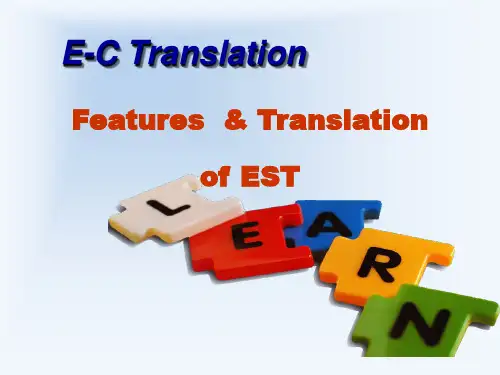
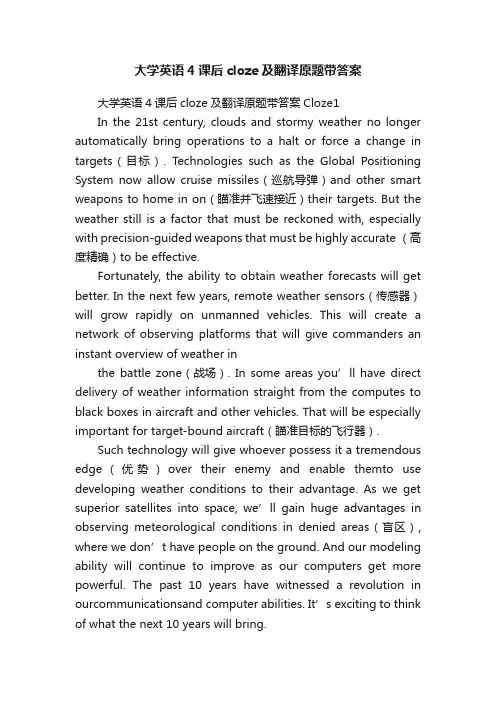
大学英语4课后cloze及翻译原题带答案大学英语4课后cloze及翻译原题带答案Cloze1In the 21st century, clouds and stormy weather no longer automatically bring operations to a halt or force a change in targets(目标). Technologies such as the Global Positioning System now allow cruise missiles(巡航导弹)and other smart weapons to home in on(瞄准并飞速接近)their targets. But the weather still is a factor that must be reckoned with, especially with precision-guided weapons that must be highly accurate (高度精确)to be effective.Fortunately, the ability to obtain weather forecasts will get better. In the next few years, remote weather sensors(传感器)will grow rapidly on unmanned vehicles. This will create a network of observing platforms that will give commanders an instant overview of weather inthe battle zone(战场). In some areas you’ll have direct delivery of weather information straight from the computes to black boxes in aircraft and other vehicles. That will be especially important for target-bound aircraft(瞄准目标的飞行器).Such technology will give whoever possess it a tremendous edge(优势)over their enemy and enable themto use developing weather conditions to their advantage. As we get superior satellites into space, we’ll gain huge advantages i n observing meteorological conditions in denied areas(盲区), where we don’t have people on the ground. And our modeling ability will continue to improve as our computers get more powerful. The past 10 years have witnessed a revolution in ourcommunicationsand computer abilities. It’s exciting to think of what the next 10 years will bring.在第二十一世纪,云层和暴风雨天气不再自动带来业务停顿或迫使目标的变化(目标)。
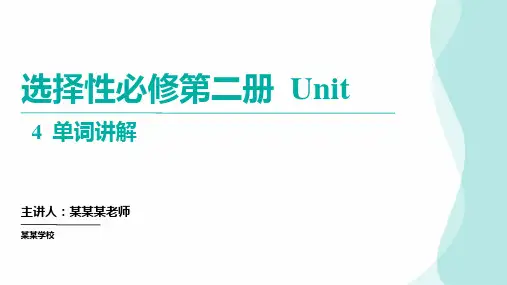
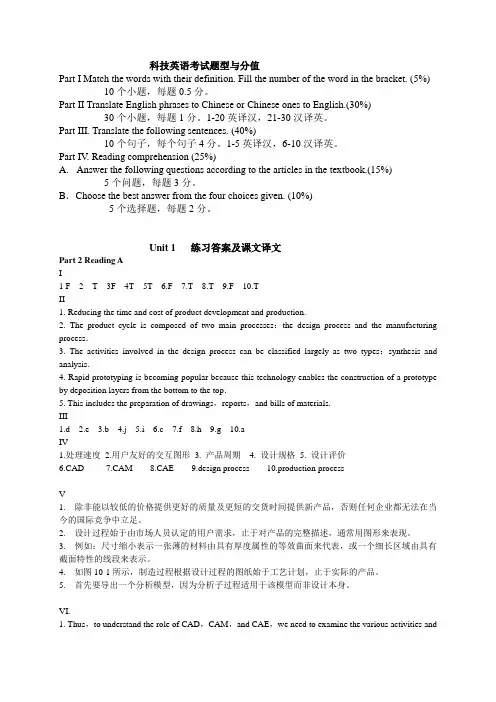
科技英语考试题型与分值Part I Match the words with their definition. Fill the number of the word in the bracket. (5%) 10个小题,每题0.5分。
Part II Translate English phrases to Chinese or Chinese ones to English.(30%)30个小题,每题1分。
1-20英译汉,21-30汉译英。
Part III. Translate the following sentences. (40%)10个句子,每个句子4分。
1-5英译汉,6-10汉译英。
Part IV. Reading comprehension (25%)A. Answer the following questions according to the articles in the textbook.(15%)5个问题,每题3分。
B.Choose the best answer from the four choices given. (10%)5个选择题,每题2分。
Unit 1 练习答案及课文译文Part 2 Reading AI1 F2 T3F 4T5T 6.F 7.T 8.T 9.F 10.TII1. Reducing the time and cost of product development and production.2. The product cycle is composed of two main processes:the design process and the manufacturing process.3. The activities involved in the design process can be classified largely as two types:synthesis and analysis.4. Rapid prototyping is becoming popular because this technology enables the construction of a prototype by deposition layers from the bottom to the top.5. This includes the preparation of drawings,reports,and bills of materials.III1.d2.e3.b4.j5.i6.c7.f8.h9.g 10.aIV1.处理速度2.用户友好的交互图形3. 产品周期4. 设计规格5. 设计评价6.CAD7.CAM8.CAE9.design process 10.production processV1. 除非能以较低的价格提供更好的质量及更短的交货时间提供新产品,否则任何企业都无法在当今的国际竞争中立足。
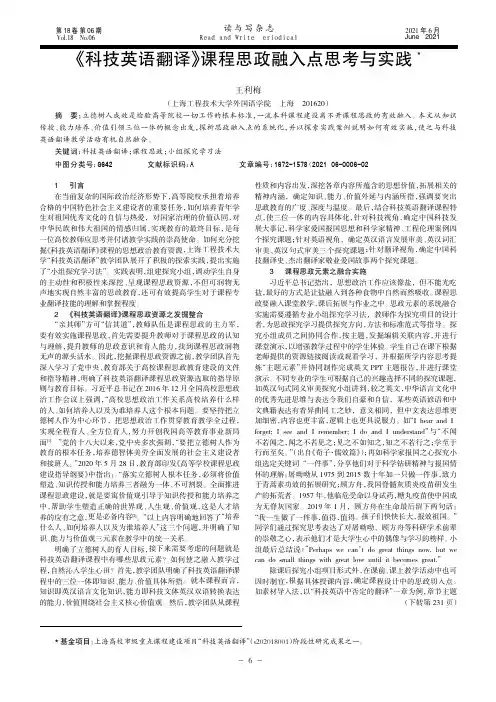
《科技英语翻译》课程思政融入点思考与实践*王利梅(上海工程技术大学外国语学院上海201620)摘要:立德树人成效是检验高等院校一切工作的根本标准,一流本科课程建设离不开课程思政的有效融入。
本文从知识传授、能力培养、价值引领三位一体的概念出发,探析思政融入点的系统化,并以探索实践案例说明如何有效实施,使之与科技英语翻译教学活动有机自然融合。
关键词:科技英语翻译;课程思政;小组探究学习法中图分类号:G642文献标识码:A文章编号:1672-1578(2021)06-0006-021引言在当前复杂的国际政治经济形势下,高等院校承担着培养合格的中国特色社会主义建设者的重要任务,如何培养青年学生对祖国优秀文化的自信与热爱,对国家治理的价值认同,对中华民族和伟大祖国的情感归属,实现教育的最终目标,是每一位高校教师应思考并付诸教学实践的崇高使命。
如何充分挖掘《科技英语翻译》课程的思想政治教育资源,上海工程技术大学“科技英语翻译”教学团队展开了积极的探索实践,提出实施了“小组探究学习法”。
实践表明,组建探究小组,调动学生自身的主动性和积极性来深挖、呈现课程思政资源,不但可润物无声地实现自然丰富的思政教育,还可有效提高学生对于课程专业翻译技能的理解和掌握程度。
2《科技英语翻译》课程思政资源之发掘整合“亲其师”方可“信其道”,教师队伍是课程思政的主力军,要有效实施课程思政,首先需要提升教师对于课程思政的认知与理解,提升教师的思政意识和育人能力,找到课程思政润物无声的源头活水。
因此,挖掘课程思政资源之前,教学团队首先深入学习了党中央、教育部关于高校课程思政教育建设的文件和指导精神,明确了科技英语翻译课程思政资源选取的指导原则与教育目标。
习近平总书记在2016年12月全国高校思想政治工作会议上强调,“高校思想政治工作关系高校培养什么样的人、如何培养人以及为谁培养人这个根本问题。
要坚持把立德树人作为中心环节,把思想政治工作贯穿教育教学全过程,实现全程育人、全方位育人,努力开创我国高等教育事业新局面[1]。
Unit 4 Meeting the MuseUnderstanding ideasWhat inspires you?Every artist’s wish is to create something that expresses an idea. But where do artists get their ideas from? Who or what inspires them? Here we find out more about the influences behind the successes of three very different artists.express v. ____________ n. __________ influence__________inspire v. _____________ n. ___________ find out ___________段落翻译:________________________________________________________________________________ ________________________________________________________________________________ Florentijn Hofman, visual artist①Florentijn Hofman is a Dutch artist, whose large sculptures are on display all over the world. One way for him to find inspiration is turning to his children’s toys. These objects have given him ideas for his animal sculptures, such as the famous Rubber Duck. A more recent work of his is the huge Floating Fish, which was set among the beautiful landscape of Wuzhen West Scenic Zone.②Hofman’s inspiration for Floating Fish came from Chinese folk tales passed down through the generations. He was particularly interested in the old story about a fish jumping through the “Dragon Gate”. This story came to life for Hofman when he visited Wuzhen and saw how people lived there.③“During the walk and my stay here in the town, I saw the fish being fed by people. You see also some fish sculpted on the wall.” These sights set Hofman’s idea for Floating Fish in motion. visual___________ turn to___________on display____________________ inspiration ___________folk tales___________ in motion___________pass…down through generations ____________________ float___________being fed by people 在句子中作___________成分,修饰____________sculpted on the wall在句子中作___________成分,修饰____________________________________________________________________________________________ ________________________________________________________________________________ ________________________________________________________________________________ ________________________________________________________________________________ ________________________________________________________________________________ ________________________________________________________________________________ ________________________________________________________________________________ ________________________________________________________________________________ _______________________________________________________________________________ Tan Dun, poser④“There is no territory in the world of music.” These are the words of Chinese poser Tan Dun. He is most widely known for posing music for the film Crouching Tiger, Hidden Dragon and the 2008 Beijing Olympics.⑤To listen to Tan’s music is to experience a mix of Chinese musical traditions and Western influences. Since his first opera, Nine Songs, Tan Dun has been using a bination of Chinese music and sounds from all over the world to tell stories. As Tan once said, Chinese music should carry “universal expression” of the human spirit so as to be recognised by the whole world.territory n. __________ poser n. _____________ v. _____________be widely known for ___________________ a mix of _______________a bination of__________________ v. _______________so as to/in order to _________________ 表_______________________________________________________________________________________________ ________________________________________________________________________________ ________________________________________________________________________________ ________________________________________________________________________________ ________________________________________________________________________________ ________________________________________________________________________________________________________________________________________________________________________________________________________________________________________________ Yang Liping, dancer⑥Yang Liping’s passion is dancing. After winning a national petition in 1986 with her Spirit ofthe Peacock dance, she has been known as the “Peacock Princess”. The inspiration for her famousdances has e from the time she spent in Xishuangbanna, Yunnan Province.⑦“I feel very grateful for the years in Xishuangbanna,” says Yang. “It gave me a chance to godeeper into the lives of various ethnic groups... Our ethnic groups, especially the Dai people, admire the peacock. They think the peacock represents the beauty of nature. I especially like the dance style of the Dai people and it gives me lots of inspiration. My dance es from their traditional belief and aims to bring out the Dai women’s beauty.”passion ____________be known as ___________________ go deeper into ________________ethnic groups _____________________ princess ____________ 王子____________She spent in Xishuangbanna, Yunnan Province 是一个__________从句,引导词_________在从句中作___________,所以省略了be/feel grateful for sth.__________bring out the Dai women’s beauty_____________________________________________________________________________________________________ ____________________________________________________________________________________ ____________________________________________________________________________________ ____________________________________________________________________________________ ____________________________________________________________________________________ ____________________________________________________________________________________ ________________________________________________________________________________________________________________________________________________________________________ Developing ideasART & TECHNOLOGY①Think “art”. What es to your mind? Is it Greek or Roman sculptures in the Louvre, or Chinese paintingsin the Palace Museum? Or maybe, just maybe, it’s a dancing pattern of lights?②The artworks by American artist Janet Echelman look like colourful floating clouds when they are lit up at night. Visitors to one of her artworks in Vancouver could not only enjoy looking at it, they could also interact with it—literally. They did this by using their phones to change its colours and patterns. Exhibits such as these are certainly new and exciting, but are they really art?③Whatever your opinion, people have been expressing their thoughts and ideas through art for thousands of years. To do this, they have used a variety of tools and technologies. Yet Michelangelo and others have been labelled as “artists” rather than “technicians”. This means that art and technology have always been seen as two very separate things.e to your mind __________________ dancing pattern of lights_________________light up_________________interact with_________________ literally______________a variety of_________________ rather than_________________ separate______________exhibits ____________ be labelled as_________________ technician_________________________________________________________________________________________________ ________________________________________________________________________________ ________________________________________________________________________________ ________________________________________________________________________________ ________________________________________________________________________________ ________________________________________________________________________________ ________________________________________________________________________________ ________________________________________________________________________________ _______________________________________________________________________________ ④Today, however, technological advances have led to a bination of art and technology. As a result, the art world is changing greatly. Now art is more accessible to us than ever before. Take for example one of China’s most famous paintings from the Song Dynasty, Along the River During the Qingming Festival. As this artwork is rarely on display, people have sometimes queued up to six hours for a chance to see it. Once in front of the painting, they only have limited time to spend taking in its five metres of scenes along the Bian River in Bianjing. Thanks to technology however, millions more people have been able to experience a digital version of this painting. Threedimensional (3D) animation means that viewers can see the characters move around and interact with their surroundings. They can also watch as the different scenes change from daylight into nighttime.technological advances________________ lead to ________________is more accessible to ________________ surroundings________________queue______________ up to________________ take in____________________ threedimensional ___________________ animation______________________________________________________________________________________________ ________________________________________________________________________________ ________________________________________________________________________________ ________________________________________________________________________________ ________________________________________________________________________________ ________________________________________________________________________________ ________________________________________________________________________________ ________________________________________________________________________________ _______________________________________________________________________________ ⑤The arttech bination is also changing our concepts of “art” and the “artist”. Not only can we interact with art, but also take part in its creation. With new technological tools at our fingertips, more and more people are exploring their creative sides. The result has been exciting new art forms, such as digital paintings and videos.⑥However, the increase in the amount and variety of art produced has also raised questions over its overall quality. Can a video of someone slicing a tomato played in slow motion really be called “art”?⑦Similarly, such developments are making the line between art and technology less distinct. Can someone unfamiliar with traditional artists’ tools really call themselves an “artist”? And is the artist the creator of the art itself, or the maker of the technology behind it? A recent project used technology and data in the same way that Rembrandt used his paints and brushes. The end result, printed in 3D, was a new “Rembrandt painting” created 347 years after the artist’s death. These advances are perhaps bringing us closer to a time when puters rather than humans create art.⑧Where technology will take art next is anyone’s guess. But one thing is for sure—with so many artists exploring new possibilities, we can definitely expect the unexpected.the arttech bination____________________ concepts ______________at one’s fingertips ______________ raised questions over ______________overall quality______________ slice______________in slow motion ______________ distinct______________that Rembrandt used his paints and brushes 是____________从句,修饰_______________when puters rather than humans create art是____________从句,修饰_______________________________________________________________________________________________ ________________________________________________________________________________ ________________________________________________________________________________ ________________________________________________________________________________ ________________________________________________________________________________ ________________________________________________________________________________ ________________________________________________________________________________ ________________________________________________________________________________ ________________________________________________________________________________。
CHAPTER ONE 科技英语的基本特点、构词法概述及阅读与翻译Lesson One科技英语的基本特点专业英语(Specialized English in Animal Science and Veterinary Medicine)属于科技英语-English for Science and Technology(Pc.ST),是英语的一种语体,在词汇、语法,修辞等方面具有自己的特色。
科技英语注重科学性、逻辑性、正确性与严密性。
因此,学习和翻译过程中要注重事实与逻辑,要求技术概念明确清楚,逻辑关系清晰突出。
内容正确无误,数据准确精密,文字简洁明了,符合技术术语表达习惯,体现科技翻译科学、准确、严谨的特征。
1教学目的:应用,可以说它是一门应用课程。
所谓应用即是指阅读、翻译(包括英汉、汉英翻译)、写作和国际交流。
新世纪对高层次的人才提出了更高的希望,英语的应用能力已经成为研究生不可或缺的一种基本素质,作为非英语专业的研究生,掌握英语的目的就是为了进行国际之间信息的交流和从事各种涉外活动,尤其是通过阅读获取科技信息,同时及时发表自己的最新科研成果。
因此,本课程的目的即在于培养研究生的应用能力,主要是英汉翻译和应用英语写作的能力。
2主要内容:三个部分.即英汉翻译,专业词汇,专业论文写作。
重点讲述科技英汉翻译的基本要求,专业论文写作部分全面介绍了论文题目(包括作者、通讯地址)、引主、材料与方法、结果与讨论、小结等的写作要求,语言、结构特点和常用的句子结构句型,以及参考文献的著录格式。
3.目标:3.1能较熟练地阅读科技文献、专业书刊和有关资料包括professional paper/scientific paper,dissertation/thesis/library paper, term/course paper,review,etc。
32能借助词典较准确地笔译本专业英文文献-Professional papers and dissertations和科技书籍-Scieatific Books.3.3能撰写英文论文摘要、了解英文专业论文的写作要求并能较准确的进行专业英语论文的写作。
六年级下册英语科普版第四课作文的笔记全文共3篇示例,供读者参考篇1Title: Notes on Grade 6 Science Lesson 4In today's science lesson, we learned about the solar system and the different planets that make it up. Here are some important notes from the lesson:1. The solar system consists of the sun, eight planets, and other celestial objects such as moons, asteroids, and comets.2. The eight planets in the solar system are Mercury, Venus, Earth, Mars, Jupiter, Saturn, Uranus, and Neptune. They are divided into two groups – the inner planets and the outer planets.3. The inner planets, also known as the terrestrial planets, include Mercury, Venus, Earth, and Mars. These planets are closer to the sun and are made up of rock and metal.4. The outer planets, also known as the gas giants, include Jupiter, Saturn, Uranus, and Neptune. These planets are fartherfrom the sun and are composed mostly of gases, such as hydrogen and helium.5. The sun is at the center of the solar system and provides heat and light to all the planets. It is a huge ball of gas that is constantly undergoing nuclear fusion, which creates energy.6. Each planet in the solar system orbits around the sun in an elliptical path. The time it takes for a planet to complete one orbit is called its year.7. The planets also rotate on their axes, which causes day and night to occur. The time it takes for a planet to complete one rotation is called its day.8. The Earth is the only planet in the solar system that has liquid water on its surface, which is essential for supporting life.9. The moon is Earth's natural satellite and orbits around the Earth. It has different phases, such as full moon, half moon, and new moon, which are caused by its position relative to the sun.10. The solar system is a vast and fascinating place, with many mysteries yet to be uncovered. Scientists continue to study and explore the planets and other celestial objects to learn more about the universe.Overall, the solar system is a complex and wondrous place that never ceases to amaze us. By studying and understanding the planets and other celestial bodies, we can gain a better appreciation for the beauty and majesty of the universe. Let's continue to learn and explore the wonders of the solar system together!篇2Title: Notes on Grade 6 Science Lesson 4Introduction:In this lesson, we will be covering some interesting topics related to Earth Science. We will be learning about the different layers of the Earth, how earthquakes occur, and the importance of protecting the environment.The Layers of the Earth:- The Earth is made up of several layers, including the crust, mantle, and core.- The crust is the outermost layer of the Earth and is made up of solid rock. It is where we live and where most of the Earth's landmasses are located.- The mantle is a thick layer of hot, semi-solid rock that lies beneath the crust. It is responsible for the movement of tectonic plates.- The core is the innermost layer of the Earth and is divided into the outer core and inner core. The outer core is made of liquid iron and nickel, while the inner core is a solid ball of iron and nickel.Earthquakes:- Earthquakes occur when there is a sudden release of energy in the Earth's crust. This energy is usually caused by the movement of tectonic plates.- The point on the Earth's surface directly above where an earthquake occurs is called the epicenter.- Earthquakes can have devastating effects, including buildings collapsing, landslides, and tsunamis.Protecting the Environment:- It is important to protect the environment to ensure a healthy planet for future generations.- One way to protect the environment is by reducing our carbon footprint. This can be done by using renewable energy sources, such as solar and wind power.- Recycling is another important way to protect the environment. By recycling materials such as paper, glass, and plastic, we can reduce the amount of waste that ends up in landfills.Conclusion:In conclusion, this lesson has taught us about the layers of the Earth, how earthquakes occur, and the importance of protecting the environment. By understanding these concepts, we can better appreciate the Earth and work towards preserving it for future generations.篇3Title: Notes on Science Lesson Four - The Solar SystemIntroduction:In the fourth lesson of the sixth-grade English science textbook, we learned about the solar system. The solar system is made up of the sun, planets, moons, asteroids, comets, and other celestial bodies. Through this lesson, we gained a betterunderstanding of our place in the universe and how Earth fits into the solar system.Key Concepts:1. The Sun: The sun is a star at the center of our solar system. It is the largest object in the solar system and provides heat and light to all the planets.2. The Planets: There are eight planets in our solar system, starting from the closest to the sun: Mercury, Venus, Earth, Mars, Jupiter, Saturn, Uranus, and Neptune. Each planet has unique characteristics and orbits the sun in its own path.3. Moons: Moons are natural satellites that orbit planets. Some planets have many moons, such as Jupiter with its 79 known moons, while others have none.4. Other Celestial Bodies: In addition to planets and moons, the solar system also contains asteroids, comets, and dwarf planets like Pluto. These objects add to the diversity and complexity of the solar system.5. The Milky Way Galaxy: Our solar system is located within the Milky Way galaxy, a vast collection of stars, planets, and other celestial bodies.Conclusion:Understanding the solar system is essential for understanding our place in the universe. By learning about the sun, planets, moons, and other celestial bodies, we can appreciate the beauty and complexity of the solar system. As we continue to explore space, we will uncover more mysteries and expand our knowledge of the vast universe beyond our planet Earth.。